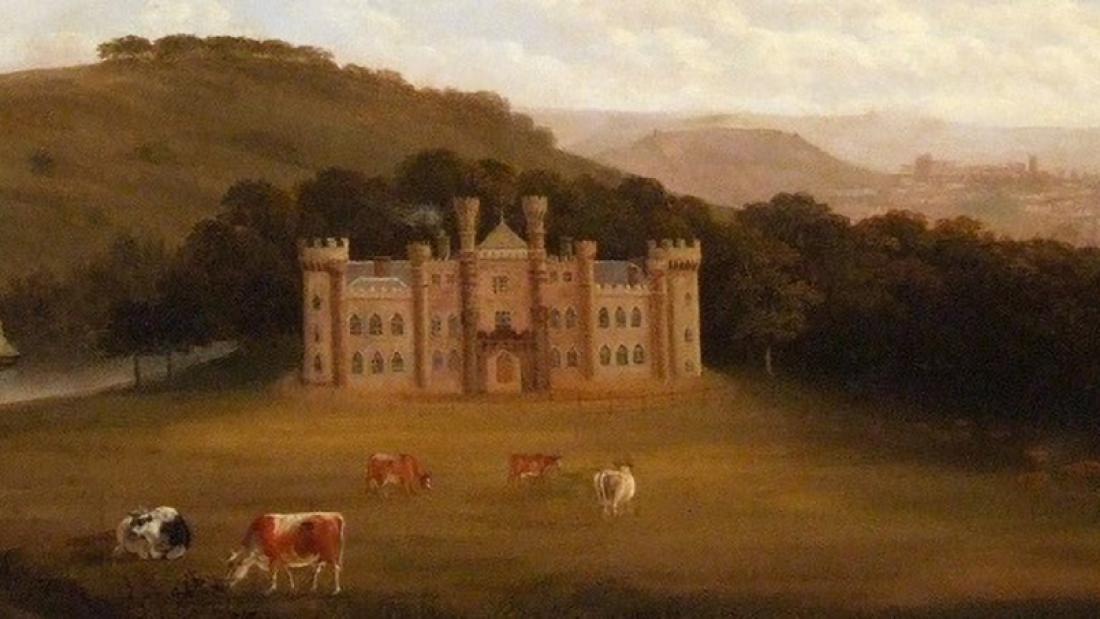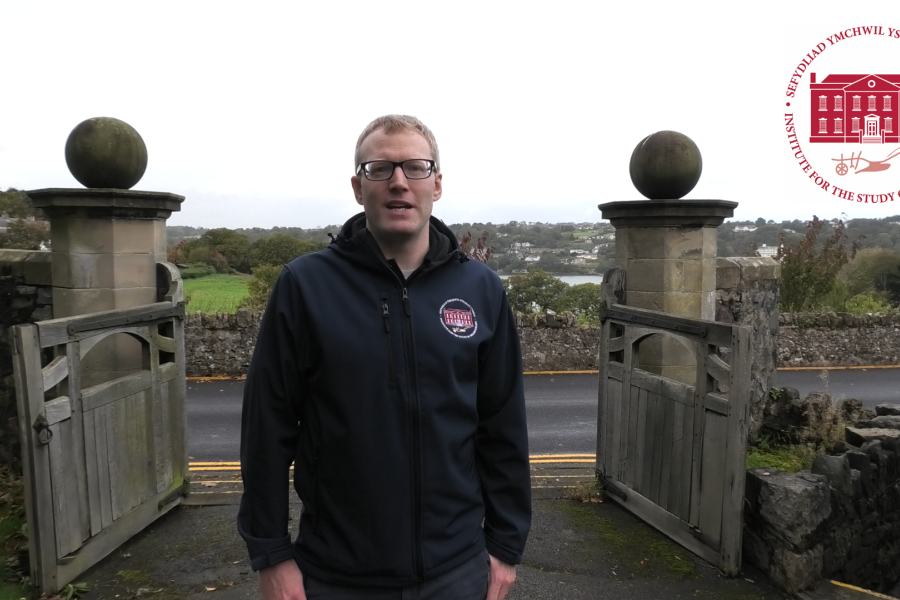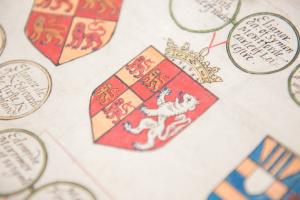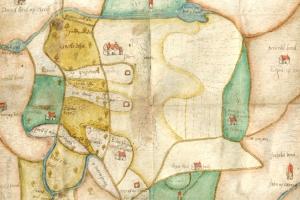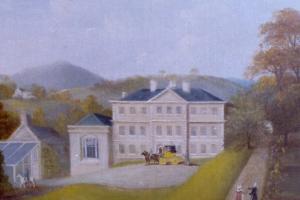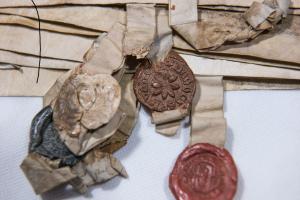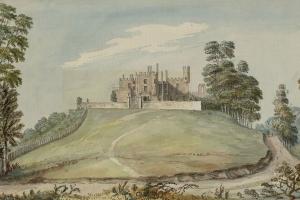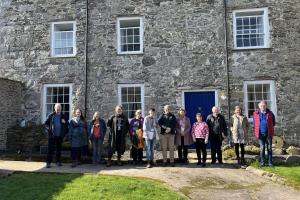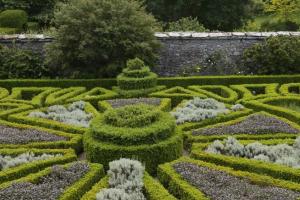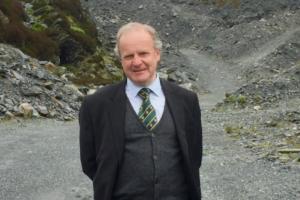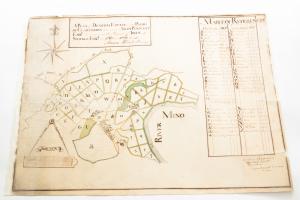About Us
The Institute for the Study of Welsh Estates (ISWE) is a national research centre which exists to enhance understanding of the role of estates and country houses in the histories, cultures and landscapes of Wales.
Their impacts and influences were often profound: up until their breakup and demise in the early-twentieth century, landed estates formed integral parts of Welsh life. It was here that much of the social, cultural, political, economic and industrial fabric of Wales was stitched together, exerting influences across local, national and global spheres.
From our home at Bangor University we use the archives, cultural heritage collections and built environments associated with these places to promote an interdisciplinary programme of research, ensuring that the knowledge we generate regarding Wales’ past is accessible and shared to contribute constructively to its future.
The following principles guide our work:
- Research excellence
- Collections-based
- Partnership and collaboration
- Interdisciplinarity
- Public and community engagement
Working with our partners, it is our objective to make a long-term contribution to the intellectual and cultural life of Wales, and to a vibrant programme of research which is international in scope and significance. We invite you to join us on this mission.
Our Approach
Based at Bangor University, ISWE is a long-term venture aimed at transforming understanding of Welsh history and culture, its landscapes, built environments and heritage collections.
This not only involves programmes of high quality scholarship, but also the building of sustained interactions between academic expertise and the nation’s archives and heritage organisations, owners and custodians of Wales’ country houses and historic landscapes, and local communities – with a view to forming and sharing new insights about Wales’ past, present and future.
All of our projects draw on the collections – of archives, manuscripts, buildings, landscapes, monuments and artwork – which were generated, collected or preserved by the estates of Wales and their associated communities and activities over many centuries.
Until now, this outstanding evidence base, held in public and private repositories across Wales, has not received concerted and coordinated academic attention. ISWE’s ambition for the next generation is to unlock its research and heritage potential through energetic collaborative projects and studies, particularly through our thriving cohort of doctoral and early-career researchers.
From the medieval period until the early-twentieth century, landed estates formed a critical part in the life and structure of Wales, occupying much of its land and influencing all aspects of society. Estate collections therefore span an exceptional range of themes and issues, from agriculture, architecture, music, politics and the economy, through to literature, industry, law and language. In analysing the profound impacts and influences exerted by estates, across all parts of Wales, ISWE is positioned to create a new body of scholarship which will refine and challenge established interpretations and perceptions of Wales’ past.
There are major opportunities for this knowledge to inform and influence Wales’ present and future – especially in the spheres of heritage interpretation, sustainable tourism, land use and the rural economy; and still more fundamentally in relation to how Welsh identities and Wales’ place in the British Isles and wider world have been formed and understood.
ISWE recognises that the people of Wales have a vested interest in understanding the history of the places and communities where they live. Contributing towards the interpretation, communication and enrichment of Welsh history; a complex history which should play an integral part in Welsh society, today and into the future, is an important part of ISWE’s identity. We are committed to sharing our pathways of discovery and exploration by opening up opportunities for community engagement as part of our research, organising expansive programmes of public events across Wales, and maintaining an active presence on social media.
The combination of locally informed studies and a national all-Wales remit is unique to ISWE. Within Bangor University we benefit substantially from our partnership with the University Archives and Special Collections. Furthermore, working closely with other institutions and equivalent research centres across Wales, the British Isles and as part of the European Network for Country House and Estate Research situates our work and findings within a vibrant intellectual context and debate, which is internationally significant and globally engaged.
The plough and the plas
Our emblem combines two elements which are central to our research priorities and important for understanding the history of the landed estate in Wales.

The plough
This delicate agricultural tool was an integral component on Welsh estates for hundreds of years. It represented a primary mechanism through which people connected with the land and was synonymous with the care and cultivation of property. In medieval times, the employment of agricultural imagery in Welsh praise poetry was commonplace, with patrons regularly honoured for their good management of the land and the provision of sustenance for the surrounding community. The plough continued to make an immense contribution to the economic viability of estates long into the twentieth century. We thought it fitting that the plough form a central part of our brand: it represents the fact that an estate was not just about the interests, activities and influence of landowners, but also about the lives and experiences of thousands of individuals who lived and worked on the land.
The plas
Over the course of late and post medieval history, the plas or Welsh country house represented an important feature of the landscape in all parts of Wales. They were the powerbases – the centres of governance, culture and politics – situated at the heart of Wales’ landed estates, and the residences of the gentry, squirearchy and aristocracy: the uchelwyr of Wales. They were important architectural structures and statements, often dominating their surrounding landscapes. Some of these buildings are still in the possession of their ancestral owners; others are cared for by organisations such as the National Trust; far too many have been demolished or are in serious risk of decay and obliteration.
The plas which features in our logo is based on the appearance of one such house which has succumbed to demolition: Ynysmaengwyn in Tywyn, Merionethshire. This exceptionally fine brink house was rebuilt from 1758 on a site which had played an important role in the locality for centuries. In medieval times, and long after, its residents were fervent patrons of the Welsh bardic order and in spite of several failures in the male line, its succession of occupants – noticeable the Wynn and Corbet families, and John Corbett (1817–1901) – continued to contribute towards the functioning of the surrounding area from the 16th century onwards. Sometime after 1951 the estate was given to the council, who were unable to maintain the upkeep of the building. The house was used for army training and firefighting practice before eventually being pulled down in 1965. Collections relating to the Ynysmaengwyn estate are held at the National Library of Wales and the Meirionnydd Record Office branch of Gwynedd Archives.
We believe that Wales’ country houses form an important part of our national heritage and can play a critical role in showcasing the diverse histories of the localities in which they are situated. Through research, engagement and collaboration we are committed to unlocking that potential.
Partnership & Collaboration
Collaboration is an integral part of our institutional identity, underpinning our approach to research, our public engagement and our efforts to make positive contributions to society and culture. Since our establishment we have sought to build connections and links with other academic partners within and beyond Wales, and with a range of organisations and individuals operating in the archives, cultural heritage, historic environment, rural affairs and tourism sectors.
Many of these relationships are essential to our long-term success. They depend on regular dialogue, the development of mutual understanding and a sense of shared objectives. Much of our research is reliant on the fantastic work of archives and heritage organisations in preserving and arranging collections to make them accessible for analysis. Our development has also been boosted through close interactions with the owners and custodians of Wales’ country houses and estates. The ability to exchange knowledge, insights and perspectives with external stakeholders is often key to the design, development and delivery of our research. Partnership assists us in developing a profile and activities right across Wales, whereas it is these connections which often provide the channels for us to share our research and findings with new and wider audiences.
ISWE forms part of a wider international network of research and heritage initiatives focusing on the historical significance of country houses and estates. The approaches and achievements of the Centre for the Study of Irish Country Houses and Estates, Yorkshire Country House Partnership and Centre for Scotland’s Land Futures have continuously provided inspiration and opportunities for international collaboration. We are also proud to be members of ENCOUNTER | The European Network for Country House and Estate Research.
The lists below give an indication of some of our key partners and stakeholders across different sectors. They have contributed to our research, offered important insights and perspectives on our work, or inspired our development.
Bangor University partners:
- Archives and Special Collections
- College of Arts, Humanities and Social Sciences
- European Travellers to Wales Project
- Research Centre Wales
- School of History, Law and Social Sciences
- Sir William Roberts Centre for Sustainable Land Use
- Stephen Colclough Centre for the History and Culture of the Book
- Treborth Botanic Garden
Research centres, projects & networks:
- British Art Network
- Centre for Scotland’s Land Futures
- Centre for the History of People, Place and Community
- Centre for the Study of Historic Irish Houses and Estates
- Colonial Countryside
- Danish Research Centre for Manorial Studies
- East India Company at Home
- ENCOUNTER | European Network for Country House and Estate Research
- Gender, Place and Memory
- Legacies of British Slave-Ownership
- Sound Heritage: Research and interpretation of music in historic houses
- Trusted Source
- Yorkshire Country House Partnership
Archives:
- Archives Wales
- Ceredigion Archives
- North East Wales Archives
- Glamorgan Archives
- Gwent Archives
- Gwynedd Archives
- Historic House Archivists Group
- National Library of Wales
- OPW-Maynooth Archive and Research Centre
- West Glamorgan Archive Service
Heritage organisations:
- Amgueddfa Cymru | National Museum Wales
- Anglesey Column Trust
- Cadw
- Decorative Arts Trust
- The Gregynog Festival
- Gwynedd Archaeological Trust
- Historic Houses
- Royal Commission on the Ancient and Historical Monuments of Wales
- National Botanic Garden of Wales
- National Library of Wales
- National Trust
- Sir Clough Williams-Ellis Foundation
- Storiel | Gwynedd Museums Service
- Llechi Cymru | Wales Slate World Heritage Site
- Welsh Historic Gardens Trust
- Women’s Archive Wales
Historical societies:
- Anglesey Antiquarian Society
- Brecknock Society
- British Agricultural History Society
- Cambrian Archaeological Association
- Carmarthenshire Antiquarian Society
- Ceredigion Local History Forum
- Cymdeithas Enwau Lleoedd Cymru | Welsh Place-Name Society
- Cymdeithas Thomas Pennant
- The Cymmrodorion Society
- Discovering Old Welsh Houses
- Flintshire Historical Society
- Gwynedd Family History Society
- North East Wales Heritage Forum
- Powysland Club
- Society for Landscape Studies
- South Wales Record Society
Archives and Collections
The extent and diversity of the historical evidence which can support and inspire research into the history of Welsh estates is substantial, ranging from archives and records, manuscripts and printed texts to landscapes, the built environment and a range of visual, material and performative culture. Our projects tend to be underpinned by the archives and cultural heritage collections which were created, collected or preserved by landed families and estates, and their associated communities and activities.
Within Bangor University we operate as a partnership with the University Archives and Special Collections.
Estate archives have represented a long-term focus in the collecting policy of Bangor University Archives and its precursors. During his time as University Librarian between 1926 and 1946, Thomas Richards (1878–1962) negotiated with north Wales landowners to secure the deposit of dozens of estate archives; a trend which continued under his successors as part of a broader strategy to establish a ‘first-class research centre for students of the history of Wales’.
The Archives and Special Collections team is responsible for the collection and long-term preservation of the archives, and to ensure that the resources are accessible to all researchers, free of charge. ISWE works with the Archives to promote the collections as valuable research and learning tools, and to communicate their public importance for understanding the histories, cultures and landscapes of north Wales. The collections are open to researchers, students and members of the public, and can be consulted on-site at the Archives and Special Collections in the Main Arts Building in Bangor University.
Bangor University’s collection of estate archives is one of the most significant in Europe. The archives cover most areas of north Wales and relate to some of the region’s most prominent estates, including Baron Hill, Mostyn and Penrhyn. The Archives and Special Collections Catalogue is available to search online (please note that although the online catalogue is being continuously improved it is still incomplete. Hard copy catalogues are available to consult in-site).
The list below is of the main estate archives held by Bangor University, including links to the descriptions of the collections on Archives Hub. The archives are arranged here by the pre-1974 counties of Wales, though it should be noted that most of the collections feature records relating to lands in multiple counties.
Anglesey:
- Baron Hill
- Bodorgan
- Dinam Hall
- Henblas
- Henllys
- Lligwy
- Llys Dulas
- Parciau
- Penrhos
- Plas Bodafon
- Plas Cadnant
- Plas Coch & Brynddu
- Plas Gwyn
- Plas Newydd
- Presaddfed & Dronwy
- Rhianfa
- Tregayan
Caernarfonshire:
- Broom Hall
- Maenan
- Meillionydd
- Penrhyn
- Plas Carreg
- Yale (Cefn Llanfair, Wernfawr and Madryn)
Denbighshire:
Flintshire:
Merioneth:
Please note that many of these collections incorporate other estate archives; for example, the Mostyn collection also contains the Corsygedol and Gloddaith estate archives. Also note that there are often other archives relating to these estates held by other repositories.
Solicitors’ Collections including estate records:
Sale Catalogues:
Items in the General Collection of Bangor Manuscripts:
- Cartographic survey of the Wern estate by Meredith Hughes (1773)
- Coming of age address presented to Sir Richard Williams Bulkeley of Baron Hill (1883)
- Diaries of William Bulkeley (1691-1761) of Brynddu
- Diaries of William Roberts, Gardner on at Plas Glynllifon (1886-1909)
- Eifionydd Farm Survey
- Gwydir Castle visitors’ book (1894-1910)
- Plas Berw estate rent roll (1723)
- Survey of the Gwaenynog estate by William Williams of Llandygai (1777-1778)
- Valuation of the Gwynfryn and Plas Hen estates (1876-79)
Bangor University Archives and Special Collections is an Accredited Archive Service.
Estate archives are especially important to the development of our work. These are accumulations of records which were produced to record and facilitate the acquisition, inheritance and management of land, and often incorporate an array of other records relating to the operation of the country house and estate and the interests, activities and careers of their owners. The chronological, geographical and subject scope of these collections can be extraordinarily broad and diverse, incorporating a range of record-types dating from the medieval period to the present day, in a variety of languages and often relating to multiple locations. Although they share common features, all estate archives are different, with their character and composition dictated by the identities of the families, estates, localities and communities which underpinned their creation and preservation.
Some of the most common record-types include:
- Title deeds
- Surveys, valuations, inventories and particulars
- Maps and plans
- Rentals and leases
- Account books and receipts
- Marriage settlements and last will and testaments
- Manorial, tithe and enclosure records
- Records relating to industrial works, roads, railways and minerals
- Personal papers including correspondence, journals and diaries
- Documents relating to local governance, administration and politics
- Genealogical papers, including pedigree rolls
- Legal papers
Our understanding of this huge corpus of evidence is very much in its infancy: the research potential is extraordinary.
Most of the archives relating to estates in Wales have been deposited in county archives and record offices across Wales, where they are made publicly accessible for research. All these archives and record offices have their own online catalogues and finding aids, though many of the collections can be searched and browed via Archives Hub. Bangor University Archives and Special Collections is home to an internationally significant corpus of estate archives relating to landed estates across north Wales. The National Library of Wales is also home to an important collection of Welsh estate archives which can be searched via NLW Archives and Manuscripts.
A minority of Welsh estate archives are still held privately by the family or estate which produced them. This especially applies to twentieth-century estate records. Some of these families and estates are members of the Historic Houses Archivists Group. It is also common to find estate records within solicitors’ collections. Other Welsh estate archives are held in repositories beyond Wales.
In addition to the information provided by estate records there are numerous other archives which inform our research. These include probate records, state papers, the records of the Welsh and English law courts, tithe maps, enclosure awards and manorial records.
Estates also exerted significant impacts on the landscape and built environment of Wales. An estate’s architectural influence often spread to farms and cottages, lodges and gatehouses, villages and towns, churches and chapels, bridges and mills, roads, walls and a whole range of industrial sites. Likewise, their influence was etched into the landscape in the layout and arrangement of parks, gardens, woodlands, fields, trees, watercourses, walls and hedges. These features provide an important foundation for research. Many of these are described in Coflein: The online catalogue of archaeology, buildings, industrial and maritime heritage in Wales and in Archwilio: The Historic Environment Record of Wales. The Discovering Old Welsh Houses group has published detailed reports on a number of pre-1700 vernacular buildings in north Wales. The RCAHMW List of Historic Place Names of Wales is an important online resource containing thousands of place names collected from historical records. The Welsh Historic Gardens Trust is a primary resource for information on the historical parks and gardens associated with Welsh country houses.
Wales’ country houses (or plastai) represent another important focus for our research. Though many of these were destroyed during the twentieth century, others have survived as important heritage sites, family homes and visitor attractions in the Welsh landscape. Many Welsh country houses in private ownership are affiliated to Historic Houses; others are cared for by organisations such as the National Trust, Landmark Trust and Cadw. Whether still in private ownership or in the custodianship of bodies such as the National Museum of Wales, the visual, material and textual culture associated with country houses provides fantastic opportunities for interdisciplinary research, notwithstanding the limitations caused by the mass sale and break-up of country house collections over the last century. Some of the portraits and artwork previously associated with Welsh country houses are available to view online via Art UK. One of the most distinctive features of cultural life in the Welsh country house was patronage and performance of Welsh praise poetry. Many of these poems survive in manuscript and can be searched online using the National Library of Wales’ Index to Welsh Poetry in Manuscript (MALDWYN).
We also recognise the significance and value of the information, memories and collections residing in local communities across Wales.
News and Blogs
Upcoming Events
Connect with us
To keep up to date with our news, activities and discoveries follow us on social media @YstadauCymru
Support Our Work
ISWE is emerging as a fresh cultural intellectual presence in the life of Wales: A new national centre dedicated to promoting innovative research and projects about our histories, cultures and landscapes.
Your philanthropic support makes a real difference to what we can achieve.
If you share our aims and aspirations and are able to contribute towards our mission, your support can help to:
- Nurture the next generation of researchers, ensuring that the study of Wales and its heritage and culture remains a vibrant academic focus.
- Unlock the incredible narratives and information found within archives and about country houses, estates and communities across Wales.
- Conserve, record, digitise and exhibit important parts of the nation’s documentary heritage, held within the University’s Archives and Special Collections.
- Promote the history and heritage of Wales to new and wider audiences, through public events, outreach activities and publications.
The most direct way to support our work is to become a Friend of ISWE. The Friends was established in response to the significant public interest in our work and their support, engagement and encouragement is crucial to our growth.
We are delighted to invite you to become a Friend and to consider a single or annual gift of £25, £50 or £100.
Donations are also welcome by cheque, credit card and Direct Debit. Please see the contact details below.
Many thanks for your support!
We also welcome larger one-off, regular or legacy gifts, including funding to support particular projects, doctoral studentships and bursaries. Please contact Dr Shaun Evans to discuss your gift:
Email: shaun.evans@bangor.ac.uk
Phone: +44 (0) 1248 383617
Post: ISWE Fund, The Development Office, Bangor University, Bangor, Gwynedd, LL57 2DG
Bangor University is a Registered Charity: No. 1141565
When you make a Gift Aid donation, we can reclaim from HMRC the basic rate tax which you have already paid on your gift. This increases the value of your gift to us by 25%, at no extra cost to you. If you are a higher rate taxpayer, you can also claim the difference between higher rate and basic rate tax on the total value of your gift to the University on your Self Assessment tax return.
For further information on how to make your gift, and how best to structure your gift to take advantage of tax relief for donors, please contact our Development Office.
Bangor University
Contact Us
You can stay up to date with the latest news and forthcoming events from ISWE by signing up to our mailing list. Just email us with your details. You can also engage with our work and interests on our social media accounts on X, Facebook and Instagram.

